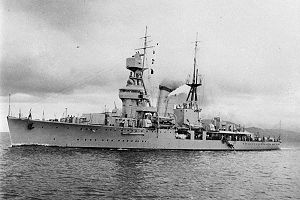- Ning Hai class cruiser
-

General characteristics Type: Light cruiser Length: 360 ft (110 m) Beam: 39 ft (12 m) Draught: 13 ft (4.0 m) Speed: 21-23kt Range: 5,000 nmi (9,300 km) at 12 kn (14 mph; 22 km/h) Complement: 361 Armament: Common
• 6 × 5.5 in (140 mm) guns
• 4 × 21 in (533 mm) torpedo tubes
• 9 × Depth Charges
Ning Hai Only
• 6 × 76 mm (3 in) AA guns
• some Vickers 2-pounder AA guns
• 10 × machine guns
Ping Hai Only
• 3 × 76 mm (3 in) AA guns
• 4 × 57 mm (2 in) AA guns
• 4 × machine gunsAircraft carried: 2 x floatplane (Ning Hai only) Aviation facilities: Hangar and crane only (Ning Hai only) The Ning Hai class were a pair of light cruisers in the Chinese fleet before World War II. Ning Hai (traditional Chinese: 甯海 "Peaceful Seas"), the lead ship of the class, was laid down in Japan while the follow-on, Ping Hai (traditional Chinese: 平海 "Amicable Seas"), was laid down in China and completed with Japanese assistance to a slightly modified design that included the deletion of seaplane facilities (Ning Hai has a small hangar for two seaplanes). While Ning Hai was quickly commissioned, tensions between China and Japan plagued the efforts to complete the Ping Hai. Both served as flagships of the Republic of China Navy, with Ping Hai taking over the role from its older sister ship since April 1937. The ROCN had an ambitious plan to procure a larger and more-powerful command cruiser and then to re-assign the two vessels as scouts/flagships of submarine flotillas, but the outbreak of war with Japan put an end to all related efforts (including the acquisition of submarines).
Ning Hai and Ping Hai were sunk in defense of the Kiangyin Fortress, Yangtze River, near Nanking by Japanese aircraft (of which the two ships shot down four) on September 23, 1937, but then re-floated by the Japanese. Originally they were to be transferred to the puppet government of Wang Jing-Wei, but the Japanese then had a change of heart and outfitted them first as barracks hulks and ultimately as escort ships Ioshima (Ning Hai) and Yasoshima (Ping Hai) in 1944.
Ships
Name Builder Laid Launched Completed Fate Ning Hai Harima Dock Co., Ltd. 20 February 1931 10 October 1931 1 September 1932 Sunk in Yangtze River on 23 September 1937 by Japanese aircraft Ping Hai Kiangnan Dock and Engineering Works 28 June 1931 28 September 1935 18 June 1936 Sunk in Yangtze River on 23 September 1937 by Japanese aircraft External links
- http://www.globalsecurity.org/military/world/japan/exchina-cl.htm
- http://big5.chinabroadcast.cn/gate/big5/gb.cri.cn/3821/2004/08/26/151@280506.htm
Ning Hai-class cruiser
List of cruisers of the Republic of China Navy Categories:- Cruiser classes
- Ning Hai class cruisers
- Naval ship stubs
Wikimedia Foundation. 2010.
